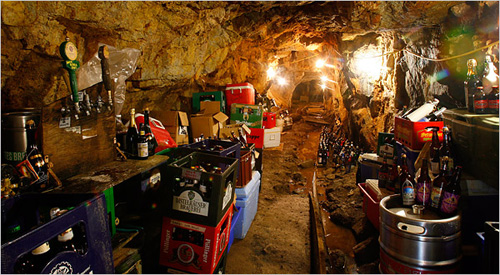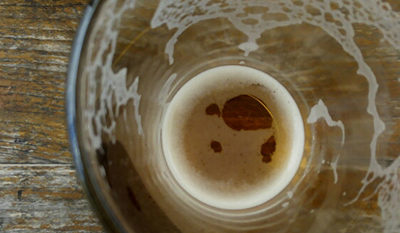How To Store Beer

With my newfound interest in aging and cellaring beers, a practice I once thought was exclusive to wine enthusiasts, I decided that I needed to do more research. Which is how I uncovered this article about storing beer. The article is pretty robust and the points raised seem pretty consistent with other results I found, so rather than writing my own, I’ll just share this one. I have made some edits but there is a link to the original at the bottom.
We’re talking about beers that beg for maturation and strict storage like vintage beers, barleywines, imperial stouts, Belgian strong ales, lambics, old ales and so on.
First, you’ll need to buy at least two of each beer. One of the beers you’ll want to drink immediately so you’ll have a comparison in which to judge the aged one – taking some notes if you want. The other beer should be cellared for at least a year.
Now there’s a lot of debate surrounding storing a beer upright vs. laying it down like a wine, specifically towards corked bottles. Some “experts” have faith in the old school wine way, that a corked beer should be kept on its side in order to keep the cork from drying out, while others believe that it doesn’t really matter. In our opinion, ALL beer should be stored upright. Here’s why we believe so, along with some other interesting facts about storage and cork:
- Cork cells are impregnated with a waxy material, called suberin, that is almost impermeable to water or gases.
- Natural cork is sometimes prone to drying out. Today’s modern plastic/synthetic, screw cap, agglomerated, technical and capsulated corks are a lot less prone to shrinkage, to the point where it’s not even worth worrying about. If a beer has been both corked and capped or corked then waxed, cork shrinkage is definitely not a major concern.
- The inside of the bottle already contains its own humidity level, and as a result will not dry out the portion of the cork inside the bottle if stored properly. It’s the cork exposed to the open air that should be of concern, however an ample amount of humidity is all that is required to stop any exposed cork from drying out during long-term storage.
- Cork problems are usually a sign of a bad cork or a cork that has passed its lifespan, not necessarily a sign of poor storage. Agglomerated corks last for about 1-3 years before beginning to disintegrate. Plastic corks eventually lose their elasticity, too. We suggest contacting the brewery to find out what type of cork they used, and its expected lifespan.
- Long storage of a beer on its side can create a yeast ring (or water-mark) inside the bottle, which will not settle. Storing a beer upright will ensure that the yeast compacts to the bottom of the bottle.
- The upright storage method decreases the amount of exposed beer thus slowing oxidation of the beer.
- Another real good reason for not storing a beer on its side is that long exposure to the cork (especially non-taint treated natural cork) can impart cork flavours within the beer. The alcohol in beer draws out that mouldy/musty character of the cork and in fact can taint the beer. In our opinion this doesn’t add any wanted complexity to the beer. Natural cork can also harbour certain fungal bacterias which are believed to create an off-flavour compound called 2,4,6, Trichloroanisole or simply TCA, which renders its victim lifeless and dull to the taste.
- Many vintage beers are kept on beer shelves for quite some time before being sold. Don’t you think beer stores would shelve their corked beers like wine, if they were meant to be laid-down like wine?
- We’ve spoken to dozens of brewers, who all recommend the upright method of beer storage. Even world-renowned brewers like Chimay and Riva suggest that you store all of their beers upright.
- Just because a self-proclaimed “beer expert” recommends that beer be laid-down like wine, doesn’t mean that they are 100% correct. There’s more than one opinion in the world, and opinions change over time.
Next, where to store? First, beer should never come into contact with heat or light. Both will wreak havoc on your delicate stash of brews, and we’re sure everyone has heard of the term “skunky”. This is often a sign of a “light struck” beer.
We recommend that you store your beer in a cool area, away from direct light, sources of heat and in a constant temperature environment. Speaking of which, temperature is very important, and a major factor in the storing and serving aspects of beer. It also can become a real balancing act. Beer benefits from cool constant temperatures; usually around 10-13° C is ideal for most beerss. Higher temperatures and you’ll risk shortening the lifespan of your beer, lower and you’ll induce chill haze (cloudy). For you beer geeks out there, we’ll break it down a bit further …
There are 3 temperatures used to lay beer down for maturation and/or storage. Not only will you want store your beers at these specific temperatures, but also you’ll want to serve them at the same. Strong beers (like barleywines, tripels, dark ales) will be their happiest at room temperature (13-16°C), most standard ales (like bitters, IPAs, dobbelbocks, lambics, stouts, etc) will be at cellar temperature (10-13°C) and lighter beers (like lagers, pilsners, wheat beers, milds, etc) will be at a refrigerated temperature (7-10°C). Usually the higher alcohol, the higher temperature and lower alcohol, the lower temperature.
Note on refrigerators: Long-term use is not recommended. Refrigerators are designed to keep food dry, so dehydration of cork can become an issue (laid-down or upright). Corked beers that you wish to age long-term should be kept in a cellar, where moderate humidity levels might be more appropriate.
Some final advice: if you cellared your beer too cold, then serve it immediately you’ll get less carbonation, less aroma and less flavour. You’ll also risk numbing your palate. Use the store temp = serve temp rule and you’ll be fine.
The original article can be found on the Beer Advocate.
Additional References:
Beer advocate also has a forum dedicated to cellaring and aging.




2 comments to “How To Store Beer”
Ron Downer - 17 Feb, 2012
Really enjoyed your comments on storing beers upright instead of laying them down. Wonder why Dupont stores their saison on the sides during the six weeks of bottle-conditioning?
Have been looking for the answer to a question posed to me by our brewery owner and wondered if you might have an answer. Why are some Belgian beers corked and then capped? It would seem cheaper to just forego the cork and use the cap only. Thanks.
BillofBeer - 17 Feb, 2012
Thanks, Ron. It seems to be an ongoing debate about the ideal way to store beer, with many falling back to the tried and true method of wineries. But there is good argument for storing upright, especially with bottle conditioned beers.
Regarding the Belgian cork and cap, don’t quote me on this, but Belgian beers tend to have quite high carbonation so the cork and cage are a more secure way of keeping the contents inside.